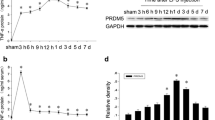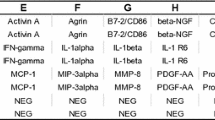Abstract
Early growth response-2 (Egr-2) protein is a transcription factor, which belongs to Egr family which involve in modulating the peripheral immune response, by means of the induction of differentiation of lymphocyte precursors, activation of T and B cells. Egr-2 plays essential roles in peripheral nerve myelination, adipogenesis, tissue repair and fibrosis, immune tolerance; however, its regulation and role in central nervous system (CNS) remain poorly understood. In contrast to Egr-1, which has been extensively investigated, the regulation and function of Egr-2 remains less well characterized. To elaborate whether Egr-2 was involved in CNS injury, we performed a neuroinflammatory model by lipopolysaccharide (LPS) lateral ventral injection in adult rats. Egr-2 expression was strongly induced in active glia cells (astrocytes and microglias) in inflamed brain cortex. In vitro studies indicated that the upregulation of Egr-2 may be involved in the subsequent glia cellular activation following LPS exposure; and knock down of Egr-2 in primary mixed glial cultures (MGC) by siRNA showed that Egr-2 promoted the synthesis of TNF-α. Collectively, these results suggested Egr-2 may be important in host defense in CNS immune response, which might provide a potential target to the treatment of neuroinflammation.




Similar content being viewed by others
References
Bielecka AM, Paul-Samojedny M, Obuchowicz E (2010) Moclobemide exerts anti-inflammatory effect in lipopolysaccharide-activated primary mixed glial cell culture. Naunyn Schmiedebergs Arch Pharmacol 382(5–6):409–417
Block ML, Hong JS (2005) Microglia and inflammation-mediated neurodegeneration: multiple triggers with a common mechanism. Prog Neurobiol 76(2):77–98
Burguillos MA, Deierborg T, Kavanagh E, Persson A, Hajji N, Garcia-Quintanilla A, Cano J, Brundin P, Englund E, Venero JL et al (2011) Caspase signalling controls microglia activation and neurotoxicity. Nature 472(7343):319–324
Dietrich PY, Walker PR, Saas P (2003) Death receptors on reactive astrocytes: a key role in the fine tuning of brain inflammation? Neurology 60(4):548–554
Droin NM, Pinkoski MJ, Dejardin E, Green DR (2003) Egr family members regulate nonlymphoid expression of Fas ligand, TRAIL, and tumor necrosis factor during immune responses. Mol Cell Biol 23(21):7638–7647
Fang F, Ooka K, Bhattacharyya S, Wei J, Wu M, Du P, Lin S, Del Galdo F, Feghali-Bostwick CA, Varga J (2011) The early growth response gene Egr2 (Alias Krox20) is a novel transcriptional target of transforming growth factor-beta that is up-regulated in systemic sclerosis and mediates profibrotic responses. Am J Pathol 178(5):2077–2090
Gehrmann J, Matsumoto Y, Kreutzberg GW (1995) Microglia: intrinsic immuneffector cell of the brain. Brain Res Brain Res Rev 20(3):269–287
Glezer I, Simard AR, Rivest S (2007) Neuroprotective role of the innate immune system by microglia. Neuroscience 147(4):867–883
Gomez-Martin D, Diaz-Zamudio M, Galindo-Campos M, Alcocer-Varela J (2010) Early growth response transcription factors and the modulation of immune response: implications towards autoimmunity. Autoimmun Rev 9(6):454–458
Gorina R, Font-Nieves M, Marquez-Kisinousky L, Santalucia T, Planas AM (2011) Astrocyte TLR4 activation induces a proinflammatory environment through the interplay between MyD88-dependent NFkappaB signaling, MAPK, and Jak1/Stat1 pathways. Glia 59(2):242–255
Hu X, Li P, Guo Y, Wang H, Leak RK, Chen S, Gao Y, and Chen J. (2012). Microglia/Macrophage Polarization Dynamics Reveal Novel Mechanism of Injury Expansion After Focal Cerebral Ischemia. Stroke
Joseph LJ, Le Beau MM, Jamieson GA Jr, Acharya S, Shows TB, Rowley JD, Sukhatme VP (1988) Molecular cloning, sequencing, and mapping of EGR2, a human early growth response gene encoding a protein with “zinc-binding finger” structure. Proc Natl Acad Sci USA 85(19):7164–7168
Li S, Symonds AL, Zhu B, Liu M, Raymond MV, Miao T, Wang P (2011) Early growth response gene-2 (Egr-2) regulates the development of B and T cells. PLoS ONE 6(4):e18498
Lieb K, Engels S, Fiebich BL (2003) Inhibition of LPS-induced iNOS and NO synthesis in primary rat microglial cells. Neurochem Int 42(2):131–137
Mandrekar-Colucci S, Landreth GE (2010) Microglia and inflammation in Alzheimer’s disease. CNS Neurol Disord: Drug Targets 9(2):156–167
Martino G (2004) How the brain repairs itself: new therapeutic strategies in inflammatory and degenerative CNS disorders. Lancet Neurol 3(6):372–378
Mayer SI, Rossler OG, Endo T, Charnay P, Thiel G (2009) Epidermal-growth-factor-induced proliferation of astrocytes requires Egr transcription factors. J Cell Sci 122(Pt 18):3340–3350
Mizuochi Y, Okajima K, Harada N, Molor-Erdene P, Uchiba M, Komura H, Tsuda T, Katsuya H (2007) Carvedilol, a nonselective beta-blocker, suppresses the production of tumor necrosis factor and tissue factor by inhibiting early growth response factor-1 expression in human monocytes in vitro. Transl Res 149(4):223–230
Obuchowicz E, Kowalski J, Labuzek K, Krysiak R, Pendzich J, Herman ZS (2006) Amitriptyline and nortriptyline inhibit interleukin-1 release by rat mixed glial and microglial cell cultures. Int J Neuropsychopharmacol 9(1):27–35
Pannu R, Singh I (2006) Pharmacological strategies for the regulation of inducible nitric oxide synthase: neurodegenerative versus neuroprotective mechanisms. Neurochem Int 49(2):170–182
Renton KW, Dibb S, Levatte TL (1999) Lipopolysaccharide evokes the modulation of brain cytochrome P4501A in the rat. Brain Res 842(1):139–147
Saijo K, Winner B, Carson CT, Collier JG, Boyer L, Rosenfeld MG, Gage FH, Glass CK (2009) A Nurr1/CoREST pathway in microglia and astrocytes protects dopaminergic neurons from inflammation-induced death. Cell 137(1):47–59
Sofroniew MV (2009) Molecular dissection of reactive astrogliosis and glial scar formation. Trends Neurosci 32(12):638–647
Sofroniew MV, Vinters HV (2010) Astrocytes: biology and pathology. Acta Neuropathol 119(1):7–35
Streit WJ, Walter SA, Pennell NA (1999) Reactive microgliosis. Prog Neurobiol 57(6):563–581
Taggart CC, Cryan SA, Weldon S, Gibbons A, Greene CM, Kelly E, Low TB, O’Neill SJ, McElvaney NG (2005) Secretory leucoprotease inhibitor binds to NF-kappaB binding sites in monocytes and inhibits p65 binding. J Exp Med 202(12):1659–1668
Topilko P, Schneider-Maunoury S, Levi G, Baron-Van Evercooren A, Chennoufi AB, Seitanidou T, Babinet C, Charnay P (1994) Krox-20 controls myelination in the peripheral nervous system. Nature 371(6500):796–799
Warner LE, Mancias P, Butler IJ, McDonald CM, Keppen L, Koob KG, Lupski JR (1998) Mutations in the early growth response 2 (EGR2) gene are associated with hereditary myelinopathies. Nat Genet 18(4):382–384
Yang L, Tanaka J, Zhang B, Sakanaka M, Maeda N (1998) Astrocytes modulate nitric oxide production by microglial cells through secretion of serine and glycine. Biochem Biophys Res Commun 251(1):277–282
Acknowledgments
This study was supported by the National Natural Science Foundation of China (No. 81070992) and funded by Project Funded by the Priority Academic Program Development of Jiangsu Higher Education Institutions (PAPD), Nantong University graduate scientific and technological innovation projects (No. YKC12030).
Author information
Authors and Affiliations
Corresponding authors
Additional information
Yaohua Yan and Xiang Tan contributed equally to this work.
Rights and permissions
About this article
Cite this article
Yan, Y., Tan, X., Wu, X. et al. Involvement of early growth response-2 (Egr-2) in lipopolysaccharide-induced neuroinflammation. J Mol Hist 44, 249–257 (2013). https://doi.org/10.1007/s10735-013-9482-y
Received:
Accepted:
Published:
Issue Date:
DOI: https://doi.org/10.1007/s10735-013-9482-y




